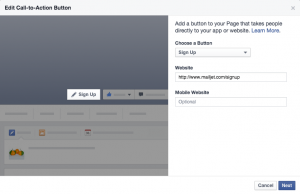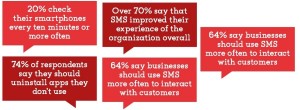If you want to launch a website, already have one for your business, or maintain someone else’s web presence, you need to know what Google Search Console is.
Until 2015, it was called Google Webmaster Tools, but the company has since rebranded it as Google Search Console. So if you see the two terms mentioned interchangeably, that’s why.
So what does Google Search Console do? A lot. The tools it provides put the considerable power of Google’s analytics at your disposal to help you manage your website and, hopefully, increase your traffic.
We’ll tell you about those tools and how to use them. And, we’ll define some common search engine optimization (SEO) terms along the way. Grab a cup of coffee and settle in.
Table of Contents
- What is Google Search Console and what does it do?
- Terms to know
- Who should use Google Search Console?
- Adding websites in Google Search Console
- The features of Google Search Console
- Using Google Search Console to tighten up your SEO
What is Google Search Console and what does it do?
According to Google, Search Console is “a free service offered by Google that helps you monitor, maintain, and troubleshoot your site’s presence in Google Search results.” It’s designed to help you understand how Google sees your website and to help improve the website’s rank in searches.
Every year, Google adds more functions to Search Console. Here are some of the things you can now do with Search Console:
- Confirm that your site can be found by Google and that Google’s web crawlers can access it.
- View search traffic data — including how often your site appears in searches, which search queries bring up your site, how often people click through to your page after searching, and more.
- Show which other websites are linking to yours.
- Troubleshoot mobile search usability problems.
- Send alerts when there are issues with your site, such as spam or indexing problems.
- Learn whether more people visit your site from desktop or from mobile.
Google Search Console can also help you build elements into your site that make it easier for web crawlers to navigate. For example, you can create and submit a site map and a robots.txt file in Search Console. Both help Google more easily categorize and navigate your page.
You don’t always need to submit a site map — Google will be able to find your site without one — but it can speed up the rate at which Google discovers your site. If you’re not sure whether to add a site map to your page, here are four situations where it makes sense to do so:
- Your site has a lot of pages. The more content your site has, the easier it is for Google’s web crawlers to miss new additions.
- Your site has many pages with very few inbound links from other pages. Known as “isolated pages,” these are harder for web crawlers to find. A site map can help direct them there.
- You just launched your site. Newer sites have fewer backlinks than established ones.
- Your site uses rich media content and/or gets displayed in Google News. A site map for this type of content makes it easier for Google to format and display your pages when it serves them in search.
Terms to know
If you’re new to the world of web traffic and SEO, you should become familiar with a few key terms that all have to do with Google Search Console’s functions:
- Crawling/web crawling: How Google discovers that your webpage exists. Its automated programs, called web crawlers, scour the internet looking for sites that are relevant to a user’s search.
- Indexing: What Google does to categorize a page after learning what it’s about. You can make that easier for Google’s web crawlers by adding a site map and robots.txt file.
- Robots.txt file: How web crawlers know which URLs they can access. This helps manage page traffic and helps a site avoid getting overloaded with requests.
- Serving: When Google delivers, or serves, search results to the user. Business owners are all trying to get their websites served on the first page of Google results, and preferably the top 10.
- Site map: How pages within your website link to one another. It’s also described as a flow chart or outline of all the pages within your website.
Search Console helps your website be more accessible and easily indexed by crawlers, which may help increase its ranking and bring in more traffic.
The more information crawlers have to work with, the better they can navigate the page, so a site map and robots.txt file are good elements to have. Spending time on these and other SEO elements is important to your business in the long run.
Who should use Google Search Console?
The short answer? Just about anyone with a website. But different people will use it in different ways:
- Business owners, especially people who own an online business, should at least be aware of Google Search Console and what it can do for them. Becoming familiar with it can teach you the basics of optimizing your site for search and get you in the habit of monitoring site traffic at the very least. Paired with a Google My Business profile, it can seriously expand your reach.
- SEO professionals and marketers, as you might expect, can get a lot out of Search Console. Tracking traffic and engagement can give you clues as to what’s working and what’s not when implementing website changes to increase traffic. Used with Google’s other tools — such as Analytics, Trends, and Ads — it can provide a detailed picture of a site’s performance.
- Site administrators and web developers can use Google Search Console’s tools to make sure their website is healthy and running properly. You can monitor site-loading issues and security concerns — that’s a good thing, as a significant deviation in site function can mean a deeper problem. For web developers, Search Console can search through code to help resolve common markup issues.
No matter what the reason or what your field is, Search Console can help you monitor your site’s performance and fix any errors that arise before they become deeper problems. From showing you whether web crawlers can access your site to whether certain keywords are declining in popularity, Search Console can give you valuable insight into your search traffic.
So now that we’ve addressed the basics — what is Google Search Console and what does Google Search Console do? — you may be wondering how to set it up for yourself.
Adding websites in Google Search Console
The first thing you need to do in Search Console is create an account. Google makes this simple. Just click “Start now” on the Google Search Console page to create the account or log in to your existing one.
On the next screen, you’ll be prompted to add a domain or website. Type your website’s URL right there, or click the three bars in the upper left corner to open the sidebar menu and click “Add property.”
If you choose to add the domain, you’ll only need to enter the domain name in — no “www” or subdomains required — and Search Console will track every page related to that domain. For example, if I were to enter “johnbogna.com,” Search Console would track all five pages of my website associated with that domain.
If you choose to enter your URL instead, you’ll need to make sure you have the URL spelled exactly right for Search Console to track it. That includes entering in “https” and not just “http” if you have an SSL-encrypted website.
Once you add your website, Search Console will ask that you verify yourself as the owner. If you choose the domain method, you’ll have to use the domain name server (DNS) option to verify ownership. Those instructions look like this:
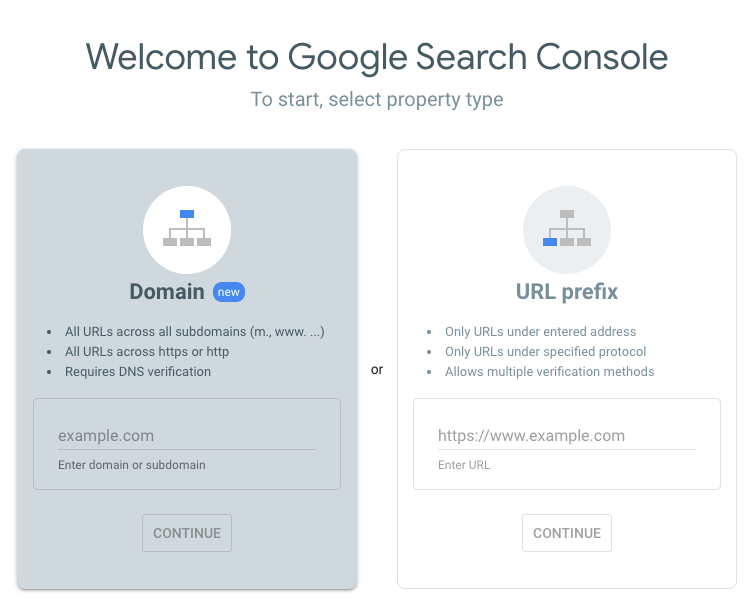
Follow these instructions to verify your domain.
Copy the code Search Console gives you, and then log in to your website provider and paste it into the DNS configuration field. How this looks will depend on what website provider you use.
No matter which provider you use, you’ll want to go to the site settings and select “domains” and then “DNS settings” to add the verification text. After that, you’ll get a screen that looks something like this:
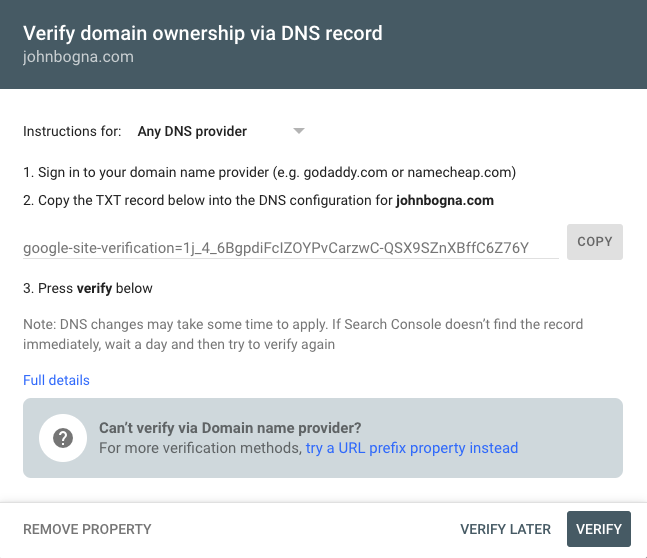
The domain verification screen in Google Search Console.
If you choose to verify your site via the URL method, the process will be similar. You’ll get a verification document to download as a file, and then you’ll upload that file to your website. Once it’s uploaded, you’ll click the “Verify” button.
Here are some other methods you can use if you choose the URL option:
- HTML tag
- Your Google Analytics account
- Your Google Tag Manager account
- Your domain name provider
Once you’ve verified your site, Google Search Console will start collecting data. There won’t be much to see at first, especially if this is the first time you’ve added a site to Search Console, but some results should show up in a day or so.
In the meantime, you can click around and start familiarizing yourself with some of Google Search Console’s features. Once enough data is compiled, you can go back and start using them.
The features of Google Search Console
Part of what Google Search Console does is offer you detailed reports on a variety of areas, based on the data it brings in. You’ll navigate through these features using tabs on the left-hand side of Search Console. It looks like this:
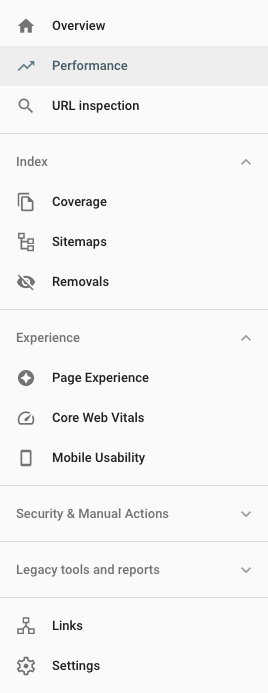
This is how the menu bar appears in Google Search Console.
We’ll go through some of the tabs you’ll see, and what they mean, in the order they’re listed.
Performance
This tab shows you which of your website’s pages are ranking in Google and what keywords they’re ranking for. The current version of Search Console lets you see data going back 16 months — almost a year and a half. And that data is collected from the moment you add your website.
Checking this tab regularly can help you see where your pages are lacking. If your homepage consistently fails to rank for the keyword you’re trying to get, you’ll see that in the performance tab. Then you can investigate and tweak the page accordingly.
The performance tab in Search Console gives you the following options to view your page stats:
- Queries
- Pages
- Countries
- Devices
- Search appearance
- Dates
These options are displayed as columns you can easily read, and they’re pretty self-explanatory. Looking across the column will tell you how your pages are performing in different countries and in search queries.
You’ll also be able to see how many people are accessing your page on a mobile device. Search appearance tells you how your site is ranking in web searches. Each of these data categories can be organized by clicks, impressions, average click-through rate (CTR), or “average position.”
Clicks tell you how often people clicked on your website in Google search results during a given time period. A low number of clicks may mean that your page isn’t standing out enough when Google serves it to people.
If that’s the case, make sure your snippet — the section Google shows to people in search lists — is as detailed as possible. Add a page description, meta and title tags, and a meta description so people get a tidy snapshot of your website.
Impressions let you know how many times your page was shown to people in Google results. You may be familiar with impressions from Twitter. It’s how many people saw it when they searched, not necessarily how many times they clicked.
You can filter impression results by a particular keyword: Click on the keyword you want to see impressions for. Say you’re a photographer in Los Angeles, and you want to see if your freelance website is ranking for the keyword “freelance photographer.” Clicking that keyword will show you impressions for just that phrase.
If you aren’t coming up in the results for that keyword, something needs to be changed. Clicking a keyword and then clicking into the Pages tab will let you see what pages are ranking for that exact keyword. It’s a good way to see if you’re optimizing your pages for the right keywords and if your efforts are paying off.
Average CTR is the average click-through rate of your website. This stat tells you what percentage of the people who saw your site in Google’s results clicked through to check it out. The higher the rank, the higher your CTR will be, but you can take other steps to help bump that number up on your own.
Adding a meta description and page title can help. If you’ve already got one, see if it can be rewritten to make it more descriptive and appealing. If it makes sense, include your focus keyword in there somewhere. Think of it as a YouTube video thumbnail — people are more likely to click the interesting ones.
Average position lets you know what the average rank of a page or keyword is for the time period you have selected. If you select “freelance photographer in LA” and look at the data for the last three months, you’ll be seeing the average rank for that keyword during that time.
This metric can vary depending on the keyword or page, as averages for Google search results are constantly changing. Take this metric with a grain of salt.
URL Inspection
This tab lets you analyze specific URLs for data. It lets you test how Google views your website by inputting the URL. Seeing how Google views your page can provide valuable insight on what to change so you can rank better.
Say you post a new blog or revamp your About Me page. You can input that URL into Google and see what it brings back. It can also tell you whether Google is even indexing your page in the first place. For example, when I run https://www.johnbogna.com through the URL inspector, it shows me my page is on Google:
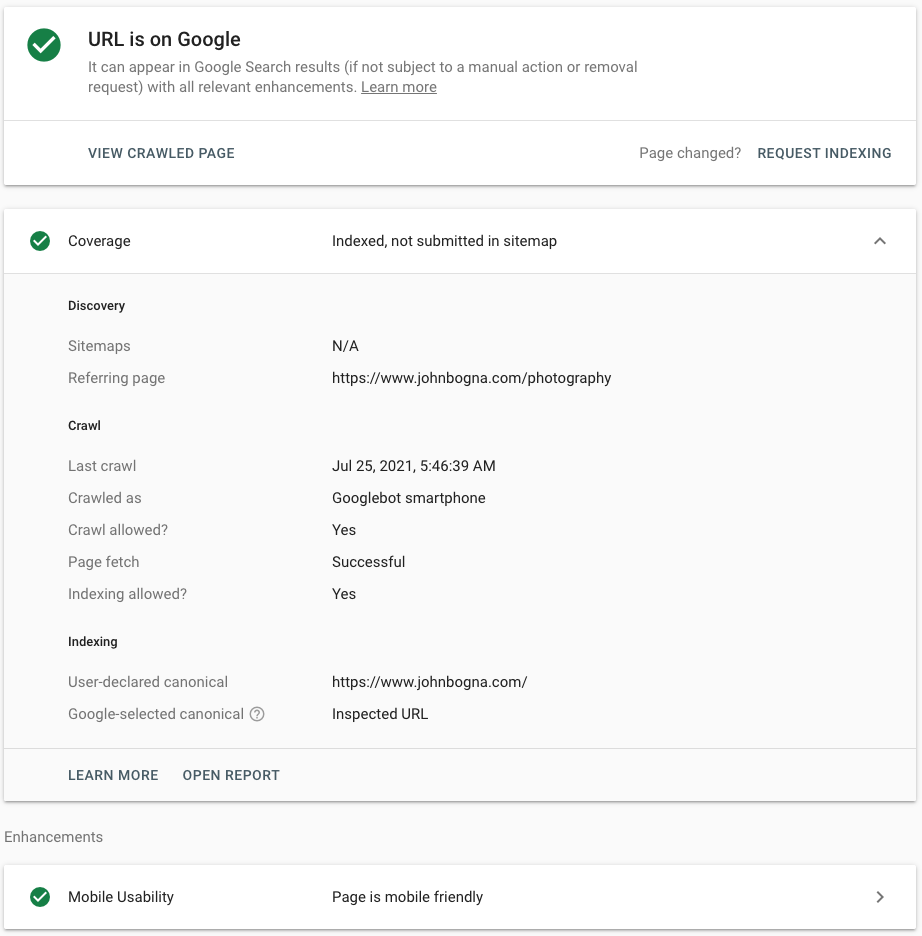
The URL analyzer tool is extremely useful for understanding how Google sees your site.
Then it offers more information on the page. Since it’s just been launched recently, there isn’t a ton of information to display. One thing you’ll see is that my page doesn’t have a site map yet. Adding one may raise the rank.
You can also see when Google last crawled my site, and what Google crawled it as (in this case, a Googlebot smartphone). The crawl was successful, and Google was able to fetch, or retrieve, the page.
If your URL is indexed on Google, there will be an Enhancements tab below this information. It contains several options for improving your site’s performance, including:
- Mobile usability
- Breadcrumbs
- Site speed enhancements
- Accelerated mobile pages (AMP)
Notice that the site ranks as “mobile-friendly” in the insights section.
The speed reports are still in the early stages, but they can still let you know if one or more of your pages are loading slowly. Speed reports tell you how quickly pages load on both mobile and desktop, so you can figure out whether speed issues are happening by device or some other cause.
Once a slow page is brought to your attention, you can go through and tweak elements, such as large image or video files, that may be causing the problem.
Google bases this data on Chrome browsing data from actual users. In the latest version of Search Console, that data can be as little as eight hours old, so Google really keeps you on top of page updates.
Index: Coverage
This tab gets a little more technical than the previous two. It tells you which of your pages have been indexed by Google and are thus available in search. If any haven’t been, Search Console will tell you what errors are keeping those pages from being indexed.
If any errors are displayed, you can get more information on them, including how to fix them, by clicking on that error in the chart. It’s a good idea to check this tab regularly so you stay up to date with any errors affecting your site. You can also set up notifications to let you know when Search Console catches a new error.
Examples of errors that could occur include:
- A non-working redirect link
- A broken link
- Broken code
Once something has been brought to your attention, you can fix it and then revalidate the page by clicking the “Validate fix” button.
Another reason to check this tab often is to make sure Google is indexing any new content you put out. If you have a blog, for example, and you post new entries regularly, those should be getting indexed by Google with the rest of your site, and the number of indexed pages in the Coverage tab should increase.
If you see a sudden drop in the number of indexed pages, it may be that Google cannot access your entire site. Check to see if something is blocking it — it could be server issues or something in the robots.txt file that keeps Google from crawling certain pages.
On the flip side of that, a spike in indexed pages when you haven’t put out new content could mean there are duplicates floating around. Duplicates happen when similar content appears at multiple URLs, making it difficult for Google to choose which site to show.
Checking the Coverage tab regularly is an easy way to quickly fix any issues that arise with your site. It’ll keep the people visiting your page happy and indicate to web crawlers that your site is well-maintained.
Links
Another helpful thing Google Search Console does is show you what other sites are linking back to yours. This tab, near the bottom of the left-hand menu bar, will give you the details on that and more.
Search Console tells you what sites link to yours, how many times they link to your content, and even what anchor text is being used in those links. The number of times people are linking to a page gets displayed next to it, so you can see which of your site’s pages are the most popular.
Links are split up by internal (within your own site) and external (coming from other pages). By tracking which pages get the most external links, you can see what’s most popular with users. The pages with the most internal links can show Google what the “cornerstones” of your site are — the evergreen and most important content at the core of your site.
Experience: Mobile Usability
With so many people browsing the web on their smartphones or other devices, it’s very likely someone’s first encounter with your site won’t be on a desktop. Google Search Console provides tools to help make sure your site’s mobile experience is a smooth one. In this tab, you can view any issues that affect how your pages appear to people viewing your site on their mobile devices.
If you’ve enabled AMP on your site, you’ll be able to see insights on how they’re performing in the URL inspection tab. You’ll see the AMP pages Google views as valid, the ones it has marked as invalid, and any errors you need to fix.
As in the Coverage section, you can view affected URLs, get more details on the error, and revalidate the page once it has been fixed.
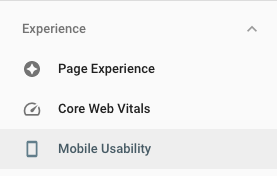
The mobile usability tab alerts you to errors that could interrupt a user’s mobile browsing.
For example, if your text is too small to read, Search Console will alert you to that here. If the content you’re using is too wide for a typical mobile screen, or clickable elements are too close to one another, that will also show up. Ideally, you’ll be testing your pages in mobile mode when putting them together, but this tab can alert you to any issues after you’ve published the site.
Using Google Search Console to tighten up your SEO
Search Console gives you a lot of data to work with, and it can be overwhelming. But it doesn’t have to be. Start slow and familiarize yourself with the broad strokes before going deeper. Upload your site, let Google gather data on it, and then go through the categories you’ve learned about here, one at a time.
Take advantage of some excellent education that Google provides, too, on how to use Google Search Console and what each of its features can do. Short articles and videos can help guide you through the finer details and reiterate the basics if you get lost.
Digital & Social Articles on Business 2 Community
(97)
Report Post
